tow CHEVROLET TRACKER 1998 1.G Service Manual
[x] Cancel search | Manufacturer: CHEVROLET, Model Year: 1998, Model line: TRACKER, Model: CHEVROLET TRACKER 1998 1.GPages: 386, PDF Size: 21.17 MB
Page 202 of 386
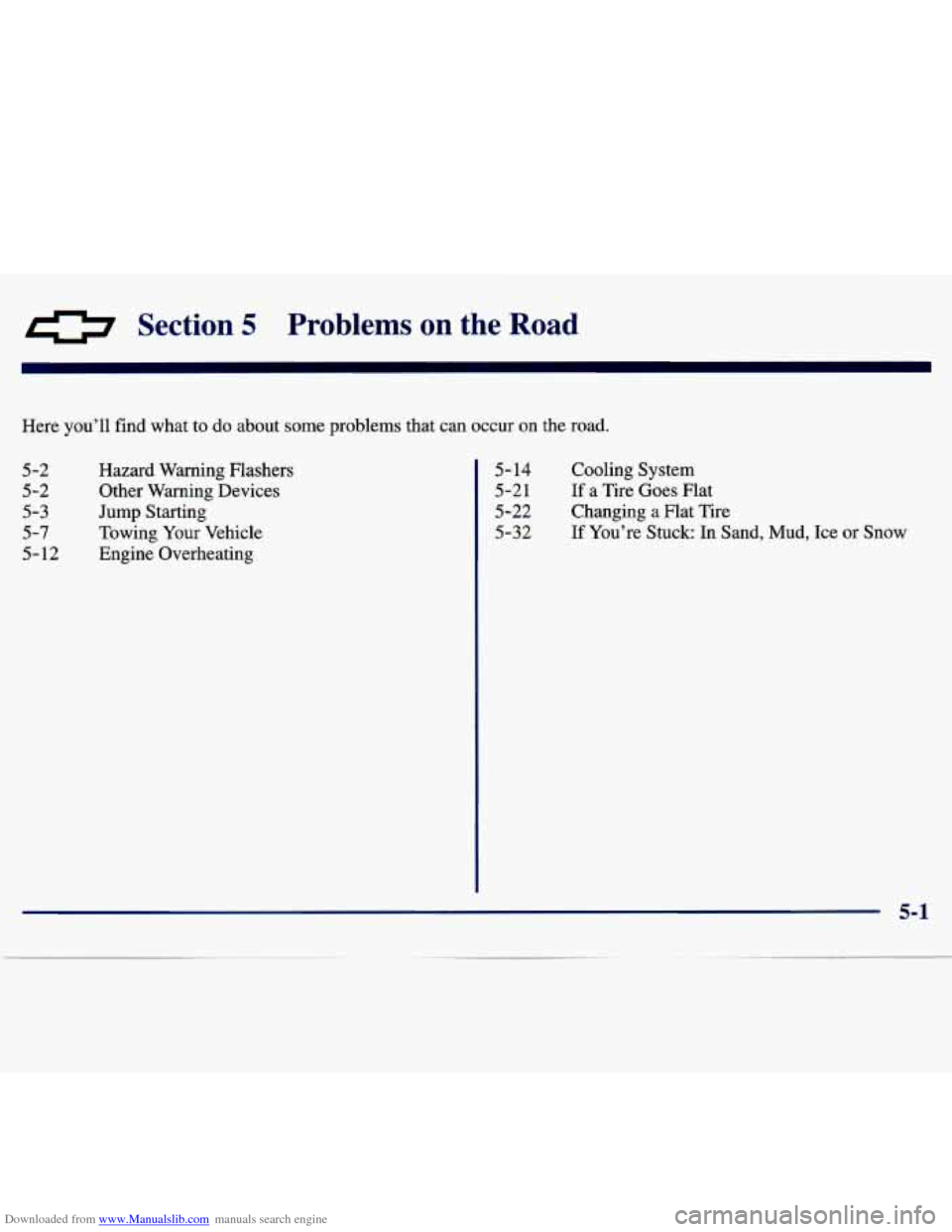
Downloaded from www.Manualslib.com manuals search engine 0 Section 5 Problems on the Road
Here you’ll find what to do about some problems that can occur on the road.
5-2 5-2
5-3
5-7
5-12 Hazard Warning Flashers
Other Warning Devices
Jump Starting
Towing
Your Vehicle
Engine Overheating
5- 14
5-21
5-22
5-32 Cooling System If a Tire Goes Flat
Changing a Flat Tire
If You’re Stuck: In Sand, Mud, Ice or Snow
5-1
Page 208 of 386
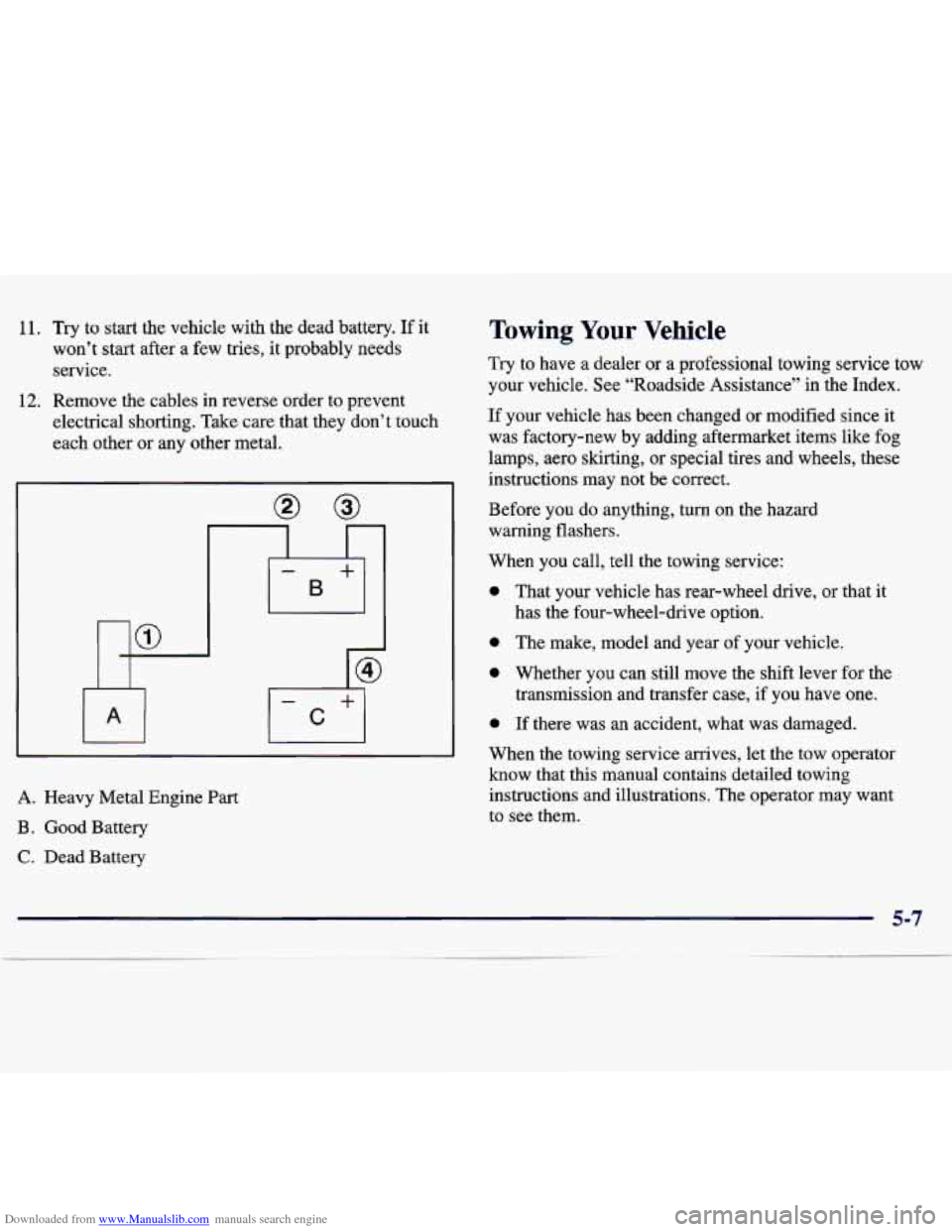
Downloaded from www.Manualslib.com manuals search engine 11. Try to start the vehicle with the dead battery. If it
won’t start after a few tries,
it probably needs
service.
12. Remove the cables in reverse order to prevent
electrical shorting. Take care that they don’t touch
each other or any other metal.
-
B
+
b
A. Heavy Metal Engine Part
B. Good Battery
C. Dead Battery
Towing Your Vehicle
Try to have a dealer or a professional towing service tow
your vehicle. See “Roadside Assistance” in the Index.
If your vehicle has been changed or modified since it
was factory-new by adding aftermarket items like fog
lamps, aero skirting,
or special tires and wheels, these
instructions may not be correct.
Before you do anything, turn on the hazard warning flashers.
When you call, tell the towing service:
0
0
0
0
That your vehicle has rear-wheel drive, or that it
has the four-wheel-drive option.
The make, model and year of your vehicle.
Whether you can still move the shift lever for the
transmission and trans€er case, if you have one.
If there was an accident, what was damaged.
When the towing service arrives,
let the tow operator
know that this manual contains detailed towing
instructions and illustrations. The operator may want
to see them.
Page 209 of 386
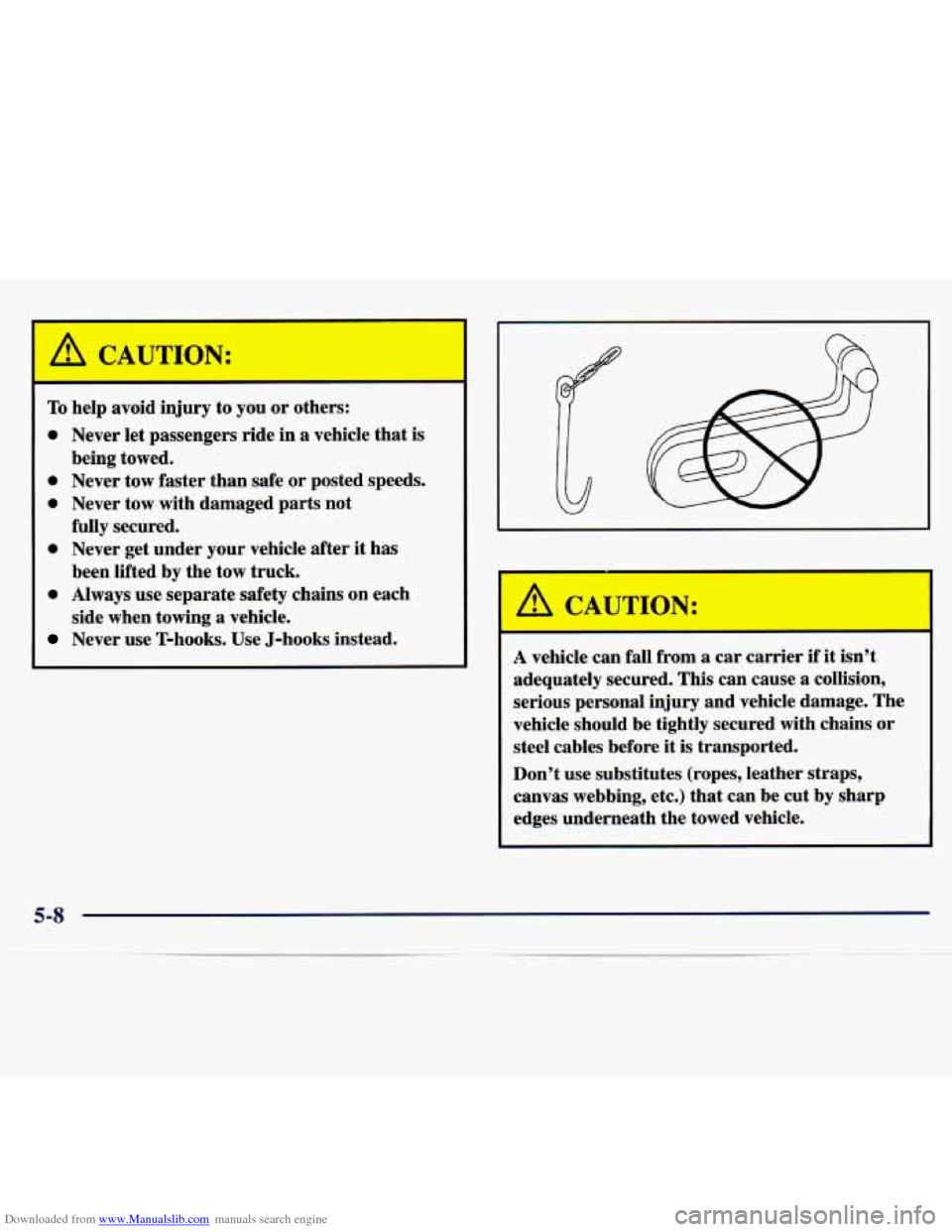
Downloaded from www.Manualslib.com manuals search engine A CAUTION:
To help avoid injury to you or others:
0 Never let passengers ride in a vehicle that is
0 Never tow faster than safe or posted speeds.
0 Never tow with damaged parts not
0 Never get under your vehicle after it has
0 Always use separate safety chains on each
Never use T-hooks. Use J-hooks instead.
being
towed.
fully secured. been lifted by the tow truck.
side when towing
a vehicle.
I r
A CAUTION:
A vehicle can fall from a car carrier if it isn’t
adequately secured. This can cause
a collision,
serious personal injury and vehicle damage. The
vehicle should be tightly secured with chains or
steel cables before it is transported.
Don’t use substitutes (ropes, leather straps,
canvas webbing, etc.) that can be cut
by sharp
edges underneath the towed vehicle.
5-8
Page 210 of 386
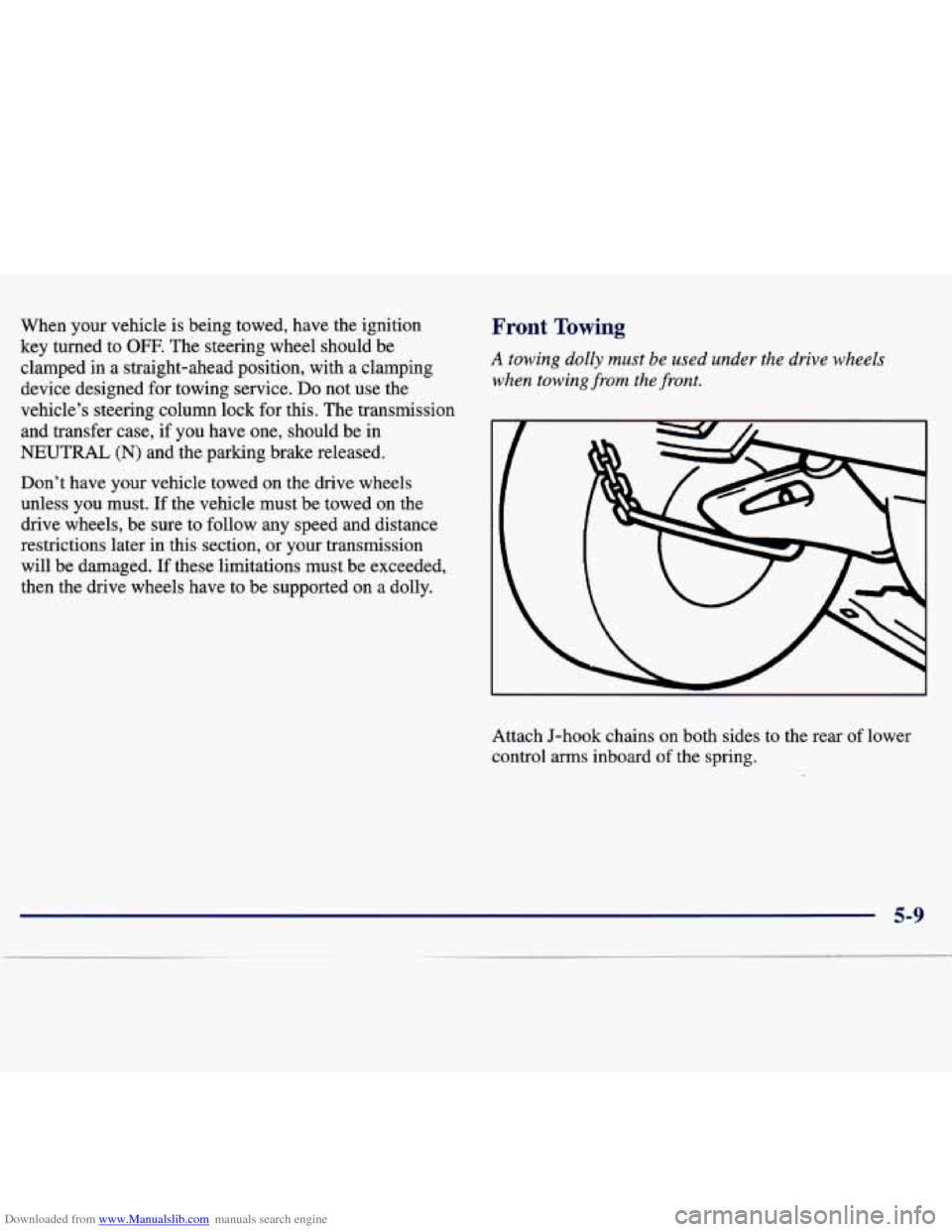
Downloaded from www.Manualslib.com manuals search engine When your vehicle is being towed, have the ignition
key turned to OFF. The steering wheel should be
clamped
in a straight-ahead position, with a clamping
device designed for towing service.
Do not use the
vehicle’s steering column lock for this. The transmission
and transfer case, if
you have one, should be in
NEUTRAL (N) and the parking brake released.
Don’t have your vehicle towed on the drive wheels
unless you must.
If the vehicle must be towed on the
drive wheels, be sure to follow any speed and distance
restrictions later in this section, or
your transmission
will be damaged. If these limitations must be exceeded,
then the drive wheels have to be supported on a dolly.
Front Towing
A towing dolly must be used under the drive wheels
when towing from the front.
Attach J-hook chains on both sides to the rear of lower
control arms inboard
of the spring.
5-9
Page 212 of 386

Downloaded from www.Manualslib.com manuals search engine Rear Towing
If your vehicle has four-wheel drive, don’t have it towed
on the front wheels unless you must. If
a vehicle with
four-wheel drive must be towed on the front wheels,, set
your manual, freewheeling hubs to FREE or unlock your
automatic freewheeling hubs, and set your transfer case
to two-wheel drive.
If your vehicle must be towed on
the front wheels, don’t
go more than 55 mph (90 kmh).
A towing dolly must be used under the front wheels
when towing
from the real:
Attach J-hooks around the axle tube.
I NOTICE:
Take care not to damage the brake pipes on the
axle
tubes.
Position the sling crossbar under and forward of the
rear bumper.
Page 214 of 386

Downloaded from www.Manualslib.com manuals search engine Steam from an overheated engine can burn you
badly, even if you just open the hood. Stay
away
from the engine if you see or hear steam coming
from
it. Just turn it off and get everyone away
from the vehicle until
it cools down. Wait until
there
is no sign of steam or coolant before you
open the hood.
If you keep driving when your engine is
overheated, the liquids in it can catch fire. You or
others could be badly burned. Stop your engine if
it overheats, and get out of the vehicle until the
engine is cool.
~~ ~ ~~ ~ ~ ~ ~ ~ ~~~~~~ ~~~~~~____
If your engine catches fire because you keep
driving with no coolant, your vehicle can be
badly damaged. The costly repairs would not be
covered by your warranty.
If No Steam Is Coming From Your Engine
If you get the overheat warning but see or hear no
steam, the problem may not be too serious. Sometimes
the engine can get a little too hot when you:
Climb a long hill on a hot day.
0 Stop after high-speed driving.
Idle for long periods in traffic.
Tow a trailer.
5-13
Page 222 of 386
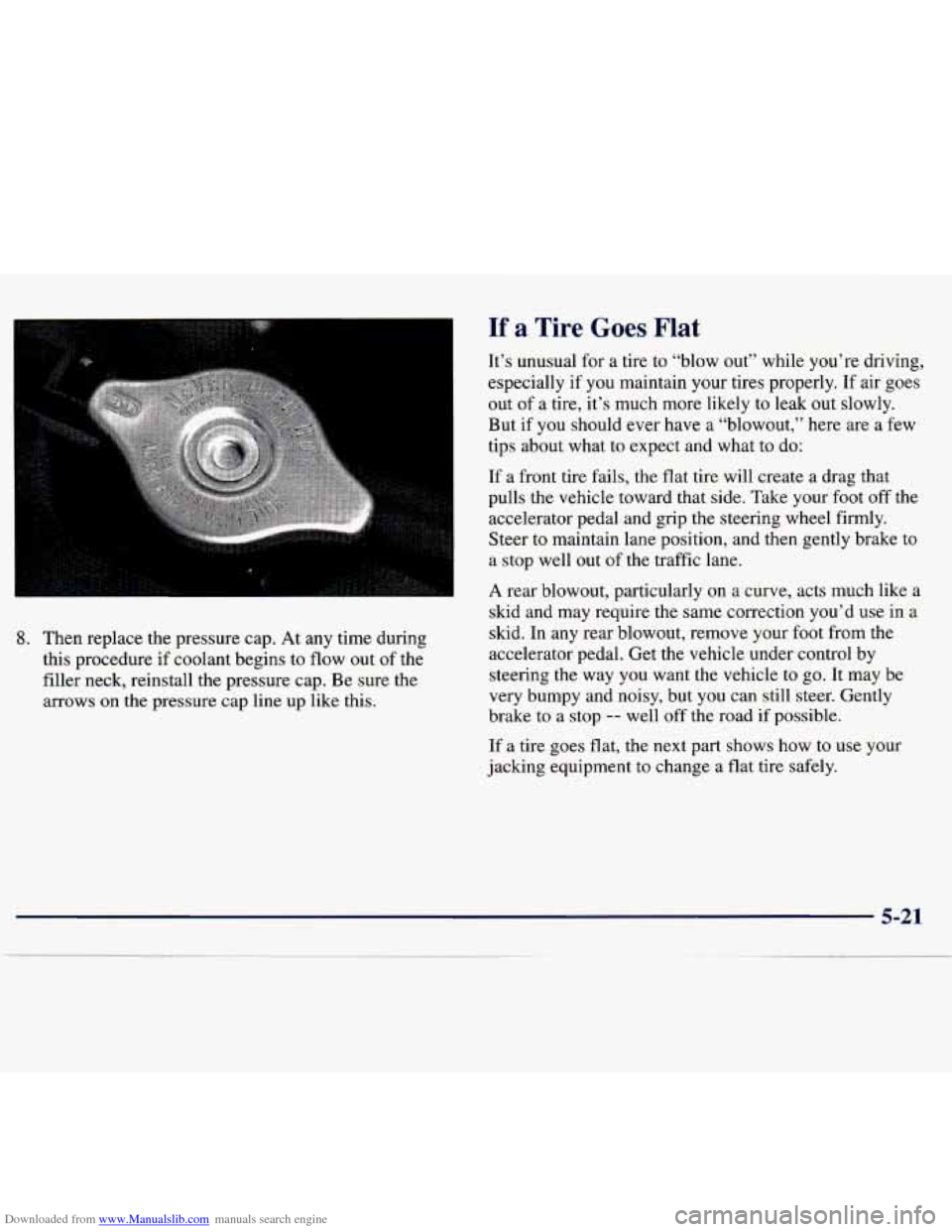
Downloaded from www.Manualslib.com manuals search engine If a Tire Goes Flat
8. Then replace the pressure cap. At any time during
this procedure if coolant begins to flow out of the
filler neck, reinstall the pressure cap. Be sure the
arrows on the pressure cap line up like this. It’s unusual
for a tire to “blow out” while you’re driving,
especially if you maintain your tires properly. If air goes
out of a tire, it’s much more likely to leak out slowly.
But if you should ever have a “blowout,” here are a few\
tips about what to expect and what to do:
If a front tire fails, the flat tire will create a drag that
pulls the vehicle toward that side. Take your foot off the
accelerator pedal and grip the steering wheel firmly.
Steer to maintain lane position, and then gently brake to
a stop well out
of the traffic lane.
A rear blowout, particularly on a curve, acts much like a
skid and may require the same correction you’d use in a
skid. In any rear blowout, remove your foot from the
accelerator pedal. Get the vehicle under control by
steering the way you want the vehicle to go. It may be
very bumpy and noisy, but you can still steer. Gently
brake to a stop
-- well off the road if possible.
If a tire goes flat, the next part shows how to
use your
jacking equipment
to change a flat tire safely.
Page 229 of 386
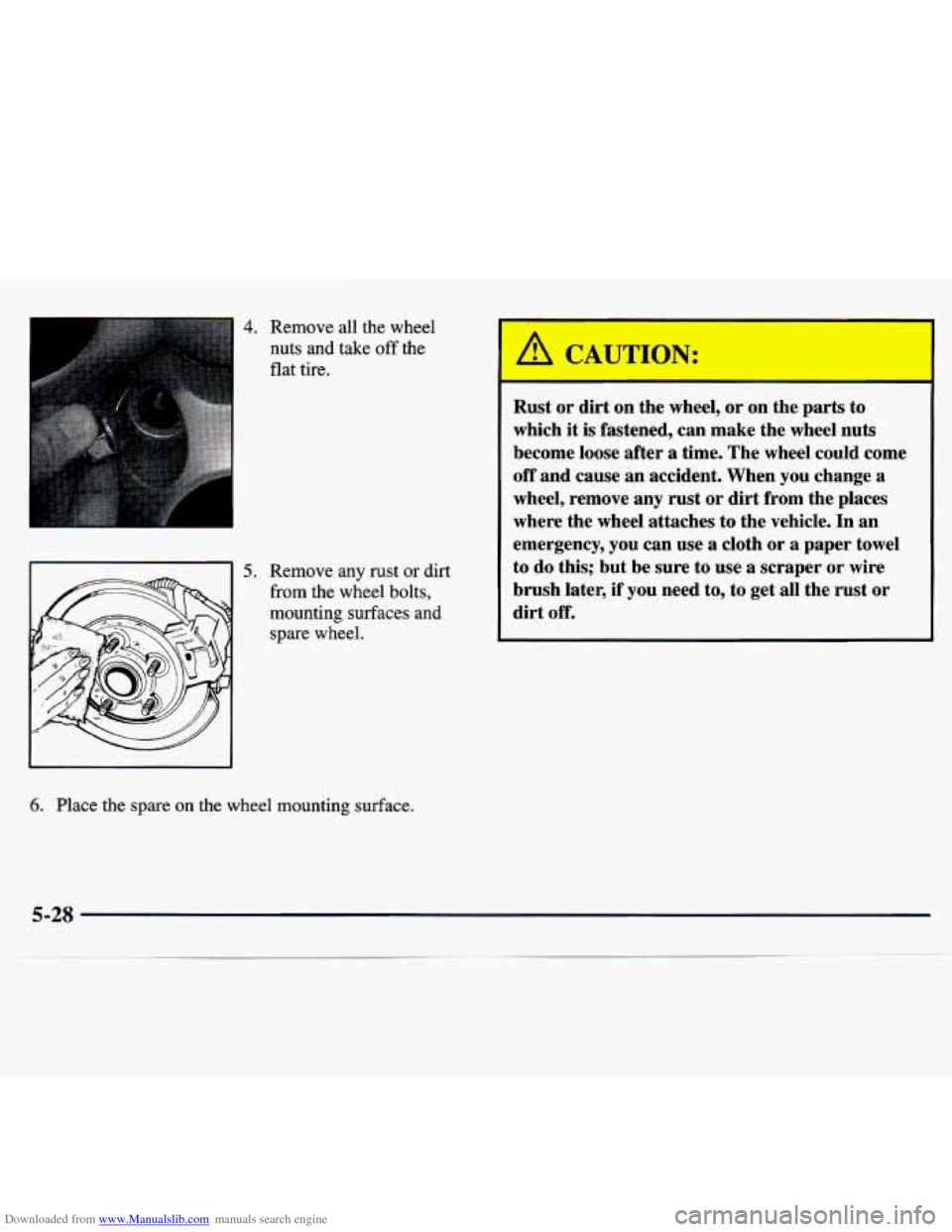
Downloaded from www.Manualslib.com manuals search engine 4. Remove all the wheel
nuts and take
off the
flat
tire.
Remove any rust or dirt
from the wheel bolts,
mounting surfaces and
spare wheel. Rust
or dirt on the wheel, or on me parts to
which
it is fastened, can make the wheel nuts
become loose after
a time. The wheel could come
off and cause an accident. When you change
a
wheel, remove any rust or dirt from the places
where the wheel attaches to the vehicle. In an
emergency, you can use
a cloth or a paper towel
to do this; but be sure to use
a scraper or wire
brush later, if you need to, to get all the rust or
dirt
off.
--.
6. Place the spare on the wheel mounting surface.
5-28
Page 230 of 386
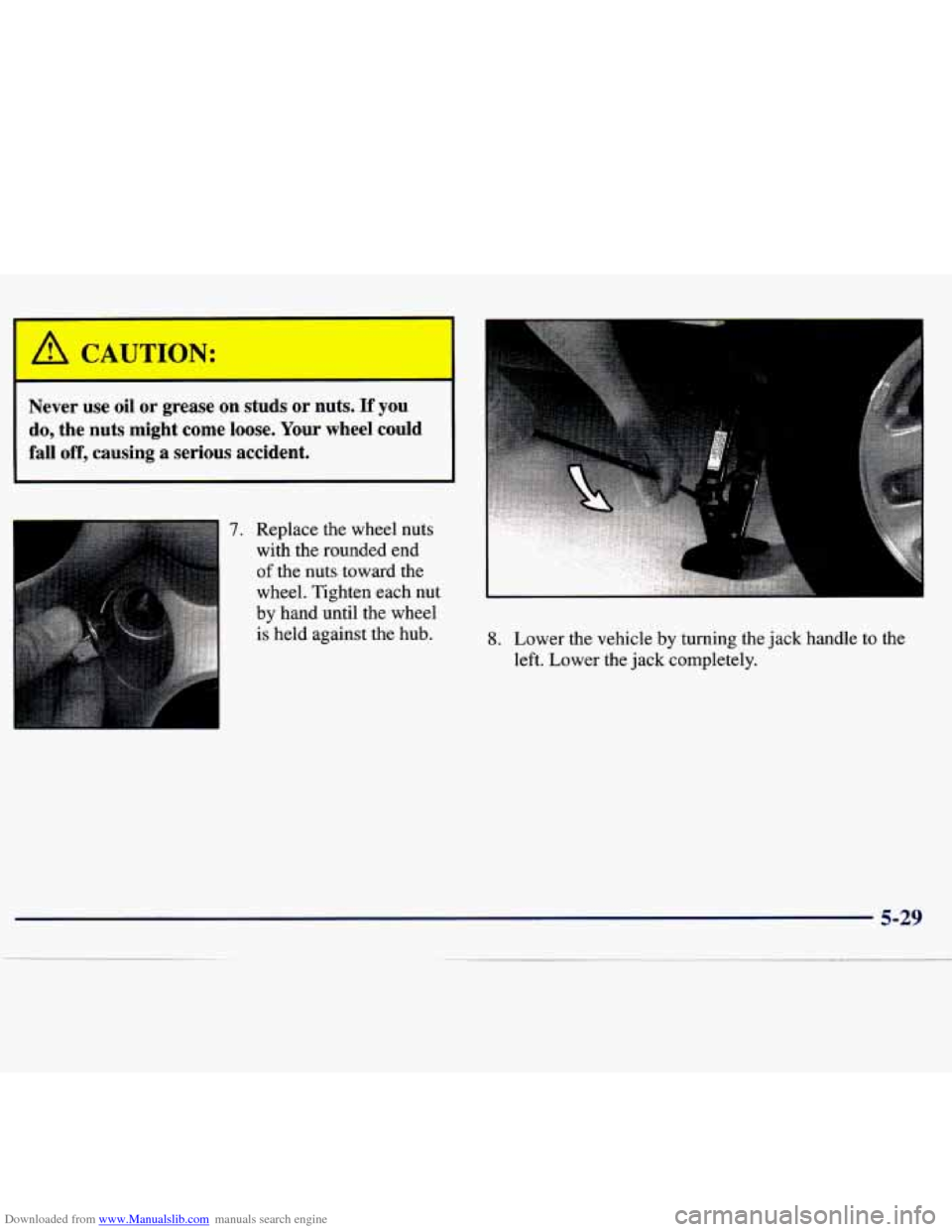
Downloaded from www.Manualslib.com manuals search engine A CAUTION:
Never use oil or grease on studs or nuts. If you
do, the nuts might come loose. Your wheel could
fall off, causing a serious accident.
7. Replace the wheel nuts
with the rounded end
of the nuts toward the
wheel. Tighten each nut
by hand until the wheel is held against the hub.
8. Lower the vehicle by turning the jack handle to the
left. Lower the jack completely.
Page 234 of 386
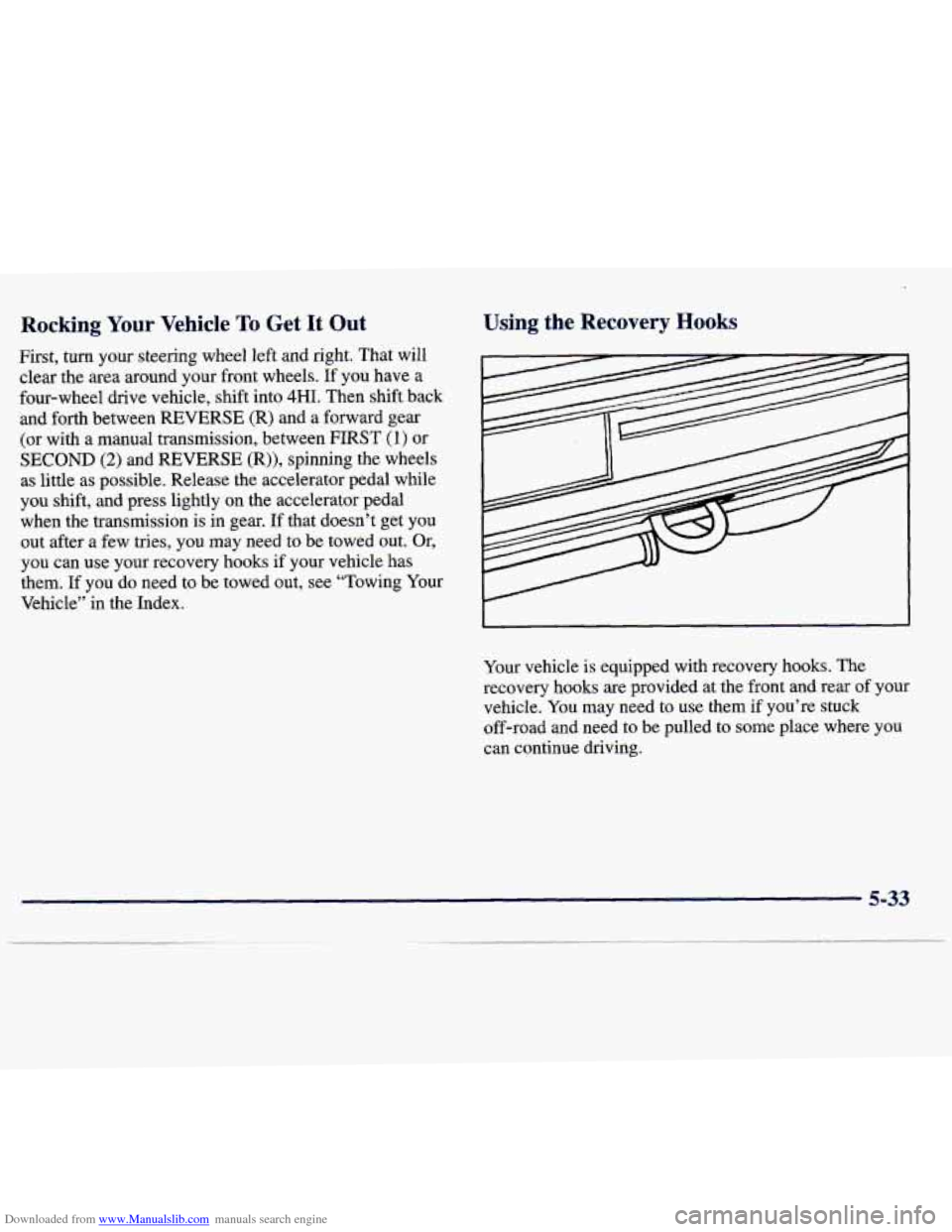
Downloaded from www.Manualslib.com manuals search engine Rocking Your Vehicle To Get It Out Using the Recovery Hooks
First, turn your steering wheel left and right. That will
clear the area around your front wheels.
If you have a
four-wheel drive vehicle, shift into 4HI. Then shift back
and forth between
REVERSE (R) and a forward gear
(or with a manual transmission, between
FIRST (1) or
SECOND (2) and REVERSE (R)), spinning the wheels
as little as possible. Release the accelerator pedal while
you shift, and press lightly on the accelerator pedal
when the transmission
is in gear. If that doesn’t get you
out after
a few tries, you may need to be towed out. Or,
you can use your recovery hooks
if your vehicle has
them.
If you do need to be towed out, see “Towing Your
Vehicle”
in the Index.
Your vehicle
is equipped with recovery hooks. The
recovery hooks are provided at the front and rear of your
vehicle. You
may need to use them if you’re stuck
off-road and need to
be pulled to some place where you
can continue driving.